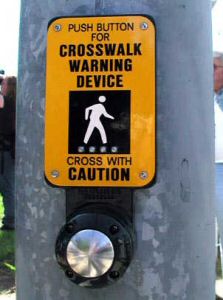
I told someone recently that I had been at a meeting dealing with a review of pedestrian crossovers, and they got that glazed look in their eyes. But once I got them actually thinking about pedestrian crossovers and the last time they used one — do they feel safe? Can you see them clearly when cycling/driving? — they got animated and involved in the issue.
Pedestrian crossovers (PXOs in city jargon) are something that a lot of people across the city use regularly, and a suprising number feel strongly about. In response to public interest, especially in the wake of some high-profile pedestrian injuries and deaths at crossovers, the city asked staff to undertake a review and propose measures to improve safety at these pedestrian facilities.
Staff have now prepared a good report, which was approved by Works Committee on May 3 and will go to city council for the May 23-25 meeting. The report focuses on crosswalks on major arterial roads, which is where all of the deaths and a disproportionate number of the injuries have occured in recent years.
The report endorses the concept of pedestrian crossovers in certain kinds of locations, because, unlike traffic signals, they allow the pedestrian to cross immediately, and then allow traffic to resume circulation immediately once pedestrians have crossed. The basic principle of these crossovers is one of negotiation — cars have to yield when they see a pedestrian step into a crossover, but pedestrians have a responsibility not to step out unless the oncoming car has enough time to stop. Apparently, those flashing ambers are just for information — the pedestrian has the right of way even if they do not push the button (I myself didn’t know that until the report).
 It turns out pedestrian crossovers are actually pretty safe. There has only been, on average, one death a year at them, and a very small proportion of pedestrian injuries. However, I suspect that part of the problem is that crossovers, precisely because of the “negotiation” aspect, don’t FEEL as safe as traffic signals.
It turns out pedestrian crossovers are actually pretty safe. There has only been, on average, one death a year at them, and a very small proportion of pedestrian injuries. However, I suspect that part of the problem is that crossovers, precisely because of the “negotiation” aspect, don’t FEEL as safe as traffic signals.
The report begins by identifying three issues that make a PXO unsafe on a major arterial road — high average (actual) vehicle speed, high vehicle volume, and more than 4 lanes to cross. Of the 77 PXOs on this kind of road, it calculates that 24 breach at least one of these conditions, and should be turned into traffic signals.
For the others, the report suggests three excellent improvements to improve the visibility of PXOs:
- – bigger and brighter amber lights (using more efficient LEDs)
- – zebra markings on the pavement
- – additional flashing amber lights at the sides of the road.
The Toronto Pedestrian Committee proposed a variety of other ideas, as well, which staff will consider as they continue the review. But these measures are a good start, and should contribute to both the real safety of crosswalks, and to the perceived safety, so that pedestrians are more likely to use them.
Staff also sensibly proposes an advertising campaign to inform drivers and pedestrians of their duties at crosswalks — very few people really know what the rules are. Once the major arterials (the most dangerous road type) have been dealt with, staff will start working on the more numerous crosswalks on smaller roads.
The thing is, though, that all this will cost money: about $2.5 million for the traffic signal conversions, and almost $500,000 for the safety measures. This is the kind of sensible, feel-good program that council likes to endorse in principle, but then cut the funding for when the budget crunch comes. When you think about it, it’s a drop in the bucket for pedestrians compared to the massive funds that are spent on maintaining roads for cars. So consider contacting your local councillor and tell them to support full funding for this pedestrian crossover program.
(I have not yet been able to find the report on the City of Toronto website, but it should be posted somewhere fairly soon).




4 comments
Last week I used a crosswalk on my way to school. After I got across the street, a driver took the time to stop his car and admonish me for having used it. “Are you for real? You made him [car in front of him] stop so that you could cross the street????”
I really hope that the city invests in improving the crosswalks….we definitely need some sort of education for drivers to respect the needs of all the people in our car-centered city. Nobody needs that kind of harrassment on their morning walk to school….
We need Red lights at the PXOs not amber lights.
Maybe this is the staff report: http://www.toronto.ca/legdocs/2006/agendas/committees/wks/wks060503/it003.pdf
This is only one small sliver of the problem. Existing laws need to be enforced, and drivers need to be aware that pedestrians are not simply pylons that impede their commute. The basic rules like not running yellows, stopping completely before making a right turn on red, not blocking crosswalks at intersections, not making quick turns without checking for pedestrians, not repeatedly edging your car forward in a threatening manner to make pedestrians “cross faster”, and so on, need to be taken seriously and enforced by the police and society in general, who still see traffic enforcement as a unimportant or a government cash grab. Until that happens, cars rule and pedestrians beware: because on foot, even when you’re right, you’re dead.
In one suburb of Seattle, they’ve embedded the yellow flashing lights in the roadway. I can say from experience that it really makes a difference — it’s impossible to miss a line of flashing yellow lights suddenly appearing in your path.
There are details here: http://www.crosswalks.com/html/reports_kirkland.html ; click “The Smart Crosswalk” at the top for a couple of photos.
I’m not sure if they’d work here, though. The lights sit slightly above the pavement, which might lead to problems with snow plows.